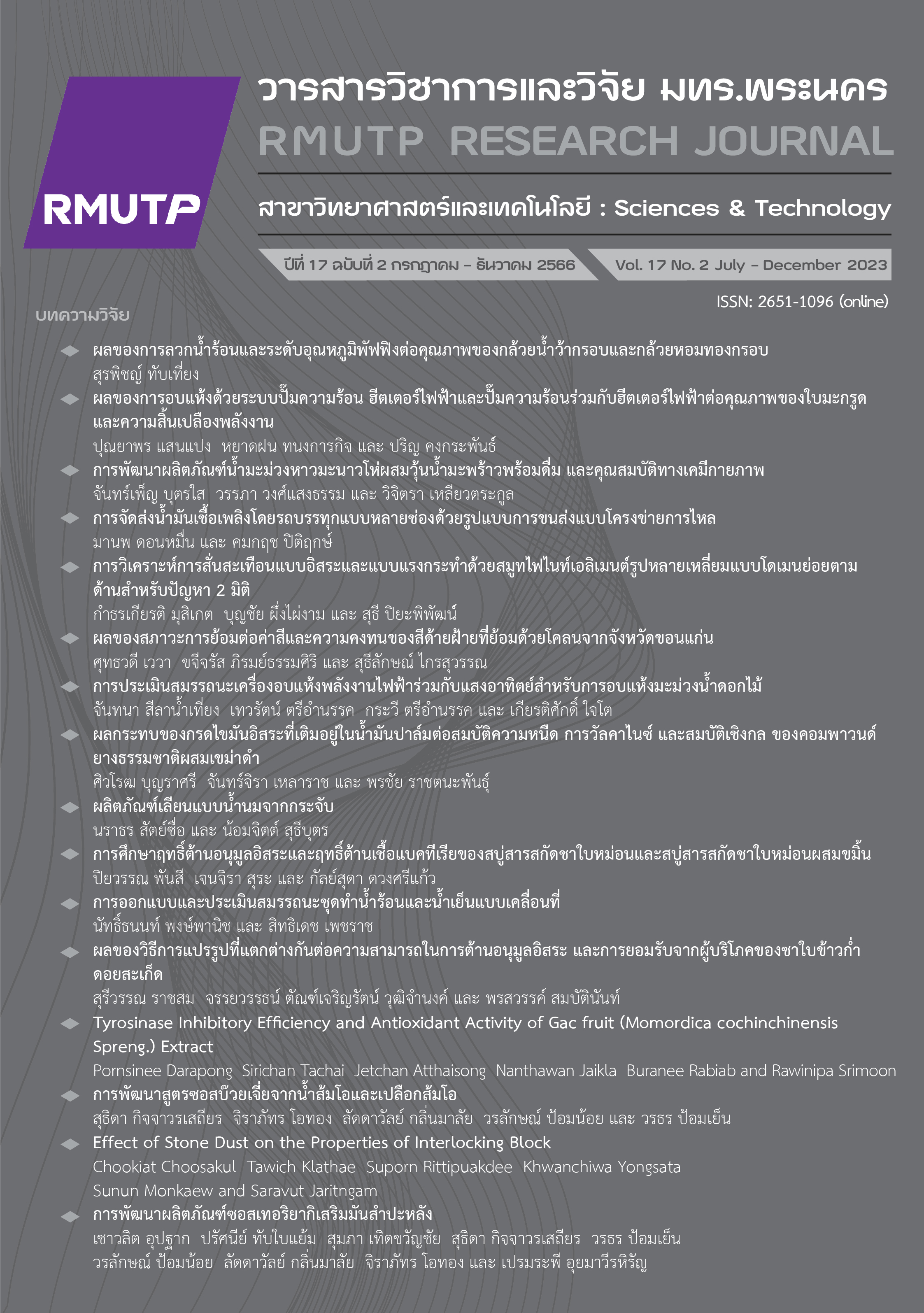The Product Development of Koranda (Carissa carandas Linn) Juice Mixed with Nata de Coco and Physiochemical Properties
Main Article Content
Abstract
Koranda (Carissa carandas L.), which is a kind of Thai local fruit that received more attention due to its health benefits. This research was aimed to develop the new product of ready to drink Koranda juice mixed with Nata de coco. The active ingredients of the Koranda were investigated. It was done in three different stages of Koranda: raw stage, semi-ripening stage and ripening stage. The result was shown that the maturation stage affected the amount of active ingredients. The ripening stage of Koranda had the highest total soluble solid, total anthocyanin content and total phenolic content9.13 °Brix, 133.59 mg cyanidin/100 g, and 540 mg GAE/100 g, respectively. The raw and semi-ripening stages of Koranda had the highest acidity and vitamin C content which were 3.99% and 45.67 mg/100 ml, respectively. The sensory evaluation of Koranda Juice was also investigated to select the optimal amount of sugar and Nata de Coco. It was found that the optimal amount of sugar and Nata de Coco in Koranda juice were 12% and 10%, respectively. Koranda Juice mixed with Nata de Coco had fiber content 0.02%, citric acid 5.37%, total phenolic content 40.14 mg/100 g, and anthocyanin 27.60 mg/100 g. Furthermore, the microbiology qualities of the product were within the Community Product Standards (Ma-maow Juice TCPS 486/2556).
Article Details

This work is licensed under a Creative Commons Attribution-NonCommercial-NoDerivatives 4.0 International License.
ลิขสิทธ์ ของมหาวิทยาลัยเทคโนโลยีราชมงคลพระนครReferences
S. Simla, “Carissa carandas L.: The fruit mentioned in Thai literature that has many health benefits,” Khon Kean Agr. J., vol. 44, no. 3, pp. 557-566, 2016.
R. Maheshwari, A. Sharma and D. Verma, “Phyto-therapeutic Significance of Karaunda B.,” Environ Pharmacol Life Sci, vol. 1, no. 12, pp. 6-34, 2012.
N. Gumlungpat, A. Charoenpanich and P. Limpachayaporn, “Biological Activity of Carissa Carandas Linn. Young Fruit Exttract on HepG2, HeLa and Human Keratinocyte Cell HaCaT,” Udon Thani Rajabhat University Journal of Science and Technology, vol. 8, no. 2, pp. 33-48, 2020.
K. Sanoppa, T. Poonyavanit and P. Pisuttipong, “Substitution of Sodium Nitrite in Sausages by Pigment Powders from Monascus purpureus Fermented with Nata de Coco,” The Journal of KMUTNB, vol. 31, no. 2, pp. 288-299, 2021.
K. Srisupak, S. Ngoenyen and P. Yuthachit. “A Study on the Optimum Amount of Saccharin for Nata de Coco Production,” Science and Technology Research Journal, vol. 5, No. 2, pp. 7-15, 2020.
A.O.A.C., “Official Methods of Analysis of AOAC International,” Gaithersburg, Md.: Association Official Analytical Chemists, 2000.
S. Fakngoen and S. Meerod, “Extraction and Separation of Anthocyanins from Carissa carandas L.,” in The 4th National Conference KPRU, Kamphaengphet Rajabhat University, Kamphaengphet, 2017, pp. 1002-1011.
N. Buachoon, “Antioxidant Activity and Total Phenolic from Seed and Fruits of Carissa Carandas,” VRU Research and Development Journal Science and Technology, vol. 13, No. 2, pp. 53-63, 2018.
S. Saithi, S. Sakhunkhu and K. Sombun, “Production of Mao (Antidesma bunius) juice mixed with Nata de coco in clear-glass bottle,” RMUTP Research Journal, vol. 10, no. 2, pp. 66-74, 2016.
N. Kumkong and S. Vatanyoopaisarn. “Development of Vinegar Drink from Fermented Indian Gooseberry,” The Journal of KMUTNB, vol. 28, no. 1, pp. 163-174, 2018.
U.S. Food and Drug Administration (USFDA). (2020, June 14). Bacteriological Analytical Manual Online (BAM online): Yeasts, Molds and Mycotoxins. [Online]. Available:https://www.fda.gov/food/laboratory-methods-food/bam-chapter-18yeasts-molds-and-mycotoxins
K. Klinsukhon, U. Sukatta, P. Rukthaworn, L. Khacharat, W. Suravanichnirachorn and P. Neumyem, “Fruit ripening stages of Carissa carandas Linn. on antioxidant and alpha- Glucosidase inhibition activities,” in Proceeding of 55th Kasetsart University Annual Conference, Kasetsart University, Bangkok, 2017, pp. 841-844.
A. Joomwong, “Effect of Maturity Stages on Physical and Chemical Quality of Carissa Carandas Linn.,” Agricultural Sci J., vol. 45, no. 3/1 (Suppl.), pp. 229-232, 2014.
T. Kayyen. “Effect of Maturation Stage on Biological Properties of Carissa carandas,” M.S. Thesis, Dept. Biotechnology Graduate School, Silpakorn Univ., Bangkok, Thailand, 2017.
N. Rattanapanone, Food Analysis Principles, Odian Store, Bangkok, 2011.
P. Rittilert and K. Warin, “Development of Karanda (Carissa carandas L.) Gummy Jelly Product,” Thai Journal of Science and Technology, vol. 9, no. 2, pp. 341-354, 2020.
W. Pewlong, ,S. Sajjabut, S. Singphet and J. Eamsiri, “Influence of Fruit Ripening Stages on the Bioactive Compounds of Carissa carandas,” Agricultural Sci. J., vol. 44, no. 2 (Suppl.), pp. 337-340, 2013.
N. Peamaroon, N. Moonrungsee, A. Boonmee, S. Suwancharoen, T. Kasemsuk and J. Jakmunee. “Phytochemical and xanthine oxidase inhibitory activity of Carissa carandas L. fruit extract,” RMUTP Research Journal, vol. 13, no. 2, pp. 106-118, 2019.
S. Simla, S. Boontang and P. Siritrakulsak. “The evaluation of some Phytochemical content and Antioxidant activity in Carissa carandas L., Khon Kaen Agr. J., vol. 41, Suppl. 1, pp. 602-606, 2013.
S. Parnsakhorn, J. Langkapin, ,P. Jamphung and C Srimas. “The production of malt high anthocyanin powder from rice berry,” Journal of Engineering, RMUTT, vol. 15, no. 2, pp. 41-50, 2017.
C. D. Sae-chan, J. Rinkham, J. Lankaew, V. Visutthithada and S. Sriyam. “Determination of Phenolic Compounds and Antioxidant Activity in Wampee (Clausena lansium (Lour.) Skeels),” Journal of Innovative Technology Research, vol. 4, no. 2, pp. 12–21, 2020.
N. Tangkawattanakul and P. Tantanasrigul, “Role of Vitamin C in the Skin,” J. Dept Med Ser, vol. 44, no. 3, pp. 7–8, 2019.
Thai Community Product Standard, Ma-maow Juice TCPS 486/2556, 2013.


